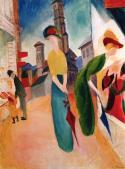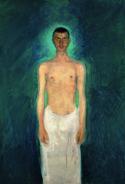Art Of The Day Weekly
#503 - from 22 February 2018 to 28 February 2018
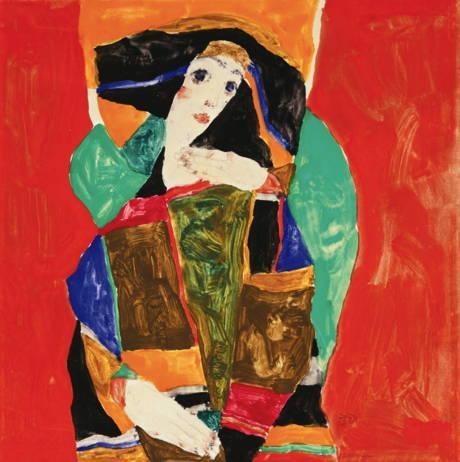
Egon Schiele, Portrait of a lady (Wally Neuzil), 1912 © Courtesy Heidi Horten Collection.
IN THE AIR
Letter from Vienna
To the Viennese, 1918 does not mean the same thing as to many other populations. Indeed, it was the end of the First World War, a war they lost. But furthermore, it was the end of a magnificent generation. Indeed, in less than 12 months, four of the creators who turned the Vienna of 1900 into a myth as strong as that of Paris at the Belle Epoque or the London of the Sixties, disappeared. They were Gustav Klimt, Egon Schiele, Otto Wagner and Koloman Moser. Some were older – such as Wagner who was 76 years old-, others were younger - Klimt was 57 years old, Moser 50- and one was definitely very young: Schiele died at 28 from the Spanish flu. That epidemic took more lives than the war itself. Vienna has taken this anniversary very seriously, one hundred years later, and has dedicated a series of exhibitions to these Fab Four and their contemporaries.
MUSEUMS
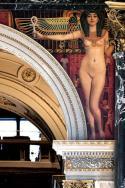
Gustav KlimtAncient Egypt, painting in the pendentive on the north wall of the Main Staircase of the Kunsthistorisches Museum Vienna, 1890/91 © KHM-Museumsverband.
A bridge over Klimt
This isn’t Lift to the Scaffold (Ascenseur pour l’échafaud) but rather Staircase for Klimt. The most famous painter of the Viennese modernity, whose frieze of the Secession must be seen by one and all, in the building designed and decorated with a golden garland by Otto Wagner, did not only paint end of the century muses. In 1890-91, at the mere age of 28, he worked rather as a decorator together with his younger brother Ernst and his friend Franz Matsch. They were chosen for a prestigious project: to decorate the arches that hang over the grand staircase at the Kunsthistoriches Museum. Twelve meters above the ground, they drew the allegorical cycle that resumes the history of art, from Egypt to our times. Since 13 February, as in 2012, during the celebration of the 150 years since Klimt’s birth, visitors have a rare privilege of climbing on to Klimt Bridge, that is a catwalk, to come up close to the figures painted by the young Viennese artist.
EXHIBITIONS
Heidi Orten, a hidden collection
The exhibition includes a few works by Picasso, by Lucian Freud, Fontana, Warhol, and even Damien Hirst. But the collection brought together by Heidi Orten holds a lot more. The enfants terribles of Modernism, and their heirs or Expressionist antagonists such as Jawlensky, Kokoschka, Mueller, among others, are present, resulting from a forced collection of the last quarter of the century. Heidi Goëss-Horten is the widow of Helmut Horten (1909-1987), the founder of a successful supermarket chain in Germany, with whom she first brought together a collection focused on German expressionism. After her husband passed away, Heidi Horten changed her priorities and explored other territories. The collection, shown here to the public for the first time, includes in particular a beautiful landscape by Klimt (Attersee, 1916) and a woman’s portrait, in a violent red, by Schiele.
• The Heidi Orten Collection at the Leopold Museum, from 16 February to 29 July 2018.
What about Gerstl?
The media scoops tend to leave certain valuable artists on the side of the road. That has been the case more or less of the Expressionist Richard Gerstl, or a meteorite like Schiele who died much too young, at 25 in 1908. The Leopold museum, which has one of the most beautiful collections of Schiele in the world, associates this talent to three other giants. Gerstl did not die during the war or from an illness. He committed suicide when composer Arnold Schoenberg discovered the love affair between his wife and the artist.
• Vienna 1900. Klimt-Moser-Gerstl-Kokoschka, at the Leopold Museum, until 10 June 2018.
Watercolors from the past
Next to the chromatic explosions, or the themed excesses by the artists from 1900 and in the period before the First World War, landscapes by Rudolf von Alt and Thomas Ender, or the botanical drawings by Moritz Michael Daffinger, the picturesque scenes by Karl Schindler seem to come from another world. And yet, they are just a few decades older than the former works and express through watercolors the certainties of the Imperial power.
• The Art of the Viennese Watercolor, at the Albertina, until 13 May 2018.
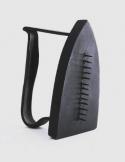
Man Ray, Gift, 1921/1958, The Museum of Modern Art, New York, James Thrall Soby Fund, 1966 © 2017. Digital image, The Museum of Modern Art, New York / Scala, Florenz © MAN RAY TRUST/ Bildrecht, Wien, 2017/18
Man Ray, always present
He has nothing to do with Vienna, nor by his origins- his parents were Russian Jews who settled in the USA - nor by his career – a large part of it spent in Paris, with trips to Philadelphia and New York in the beginning, then to Hollywood in the 40s-. But Man Ray’s iconoclasm offers an interesting parallel with the audacities of the Modernists a few years before him. As a matter of fact, this retrospective shows not only his usual photographs, but looks at all hos work: he was most probably the most provocative, and subversive with his Surrealist objects. Who would actually like to receive one of his Gifts!
• Man Ray at the Kunstforum, from 14 February to 24 June 2018.
OPENINGS OF THE WEEK

RÉSIDENCES SECONDAIRES
24 February 2018 - NANTES - Galerie RDV
Two artists from the Loire Valley - Frédéric Bonjean and Mathieu Archambault - create their own geography

